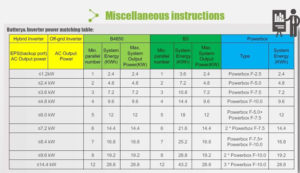
Phone
+27 82 552 7775
Email
sales at powerdotdata.com
Address
Johannesburg, South Africa
What Is a Battery’s C Rating?
Looking for the correct batteries for your proposed solar installation can be a daunting task. There are so many options to choose from, Gel AGM, Lead Acid, Lithium Ion (LiFePo), Deep Cycle, etc, etc, etc. The list goes on and on.
One of the terms you will come across during your research is the “C-Rating” of a battery and you will look at it and think, “what the heck is that?”. So you will then search the internet for this, and will be even more confused by most of the answers that you receive, wondering how this will apply to your requirements?
To put it simply, the C-Rating of a battery is how much power it can discharge at any one time, based on the size of the battery. In other words, if you are looking at a battery with a kilo Watt Hour rating of 2kWh and a C-Rating of 1 it means that at any time it can discharge 2kW of power.
If that same 2kWh battery has a C-Rating of 0.5 it will only be able to discharge 50% of that (1kW) at any one time.
If the battery has a C-Rating of 1.5 it will then be able to discharge 3kW of power or 150% of the rated power at any one time.
OK so why is this important?
This is important because it affects the amount of batteries that you will require for your inverter.
Say you are looking at a 5kW hybrid or off-grid inverter for your home or office, and you know that your peak power draw (the maximum amount of power that you will draw at any one time) will be close to 5kW. You will then need at least 5kWh’s (100Ah’s) of batteries with a 1C rating in order to cater for that. If the batteries only have a 0.5C rating then you will need at least 10kWh’s (200Ah’s) of batteries.
If you do not see a C-Rating anywhere in the specifications then you can quite easily work it out using a simple formula:
(Battery Voltage) x (Continuous Discharge Current) x (No. of Batteries) = (Maximum Continuous Discharge Power)
For example, let’s say that you have a 5kW Inverter and you are looking at purchasing the Pylontech US3000 battery for your inverter. The Voltage of the US3000C is 48V, the recommended Discharge Current is 37A.
48 x 37 = 1,776 W or 1.776kW
5000W / 1,776W = 2.815 which we will round up to 3
This means that for your 5kW inverter you would require a minimum of 3 x US3000C batteries.
This is the reason that certain manufacturers stipulate the maximum sized inverter for a number of a particular model of battery. I have posted and example of Pylontech’s recommendations below as they are one of the most popular batteries used in solar installations.

C-Ratings and the correlation to Coulombs Law can start to get quite complicated when working out battery requirements down to the n-th detail and should be left to professional installers, but as a general guide this article should point you in the right direction, and stop you being conned by then next person that says “Oh no, you will only need 1 battery for your installation.”